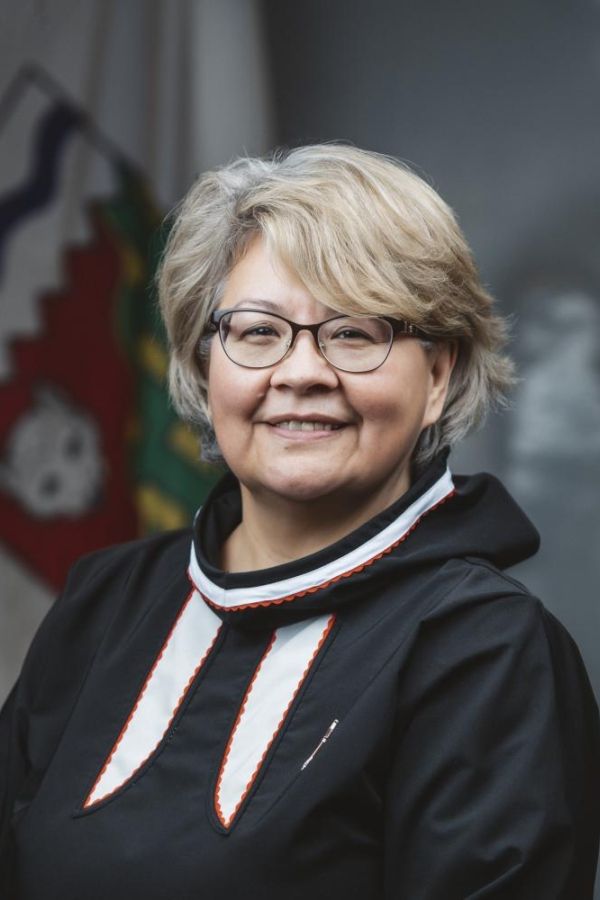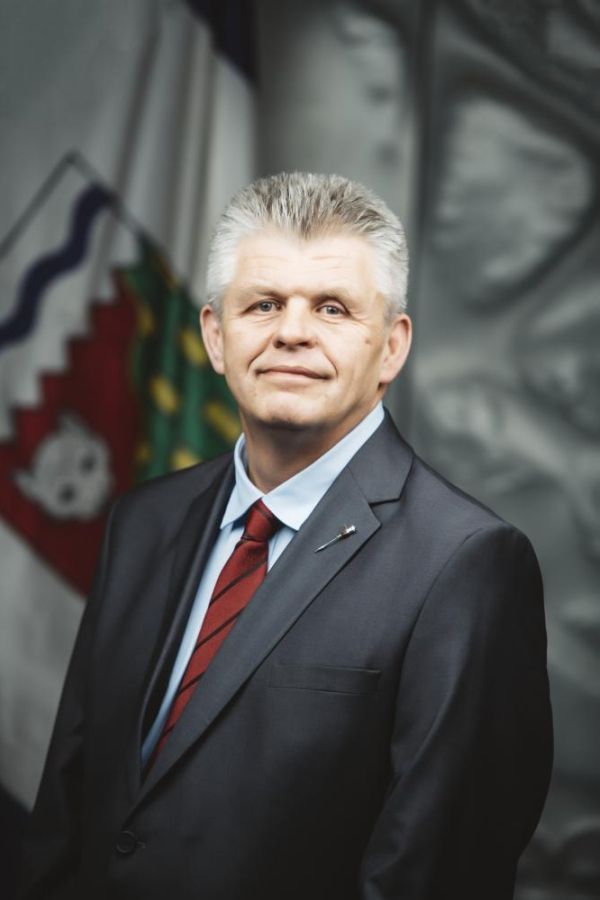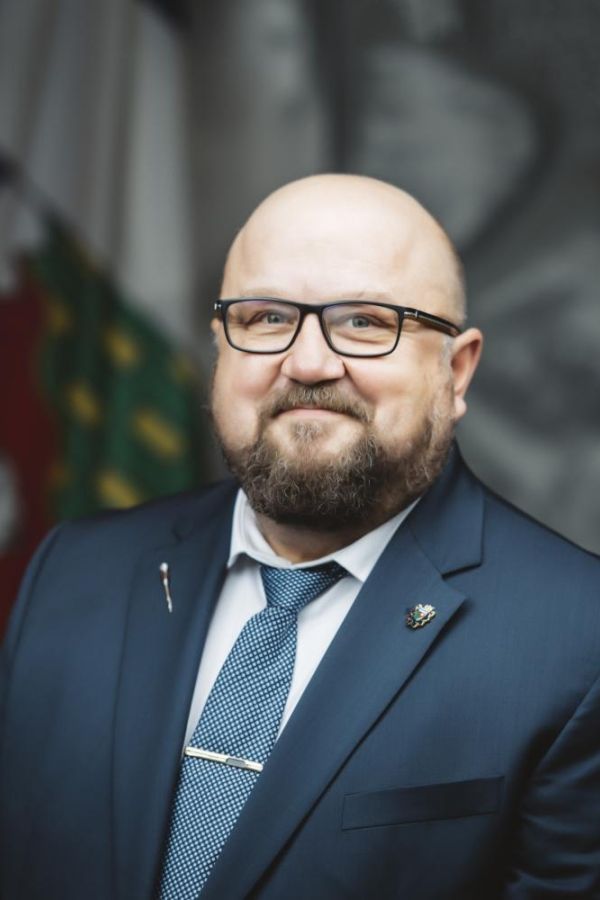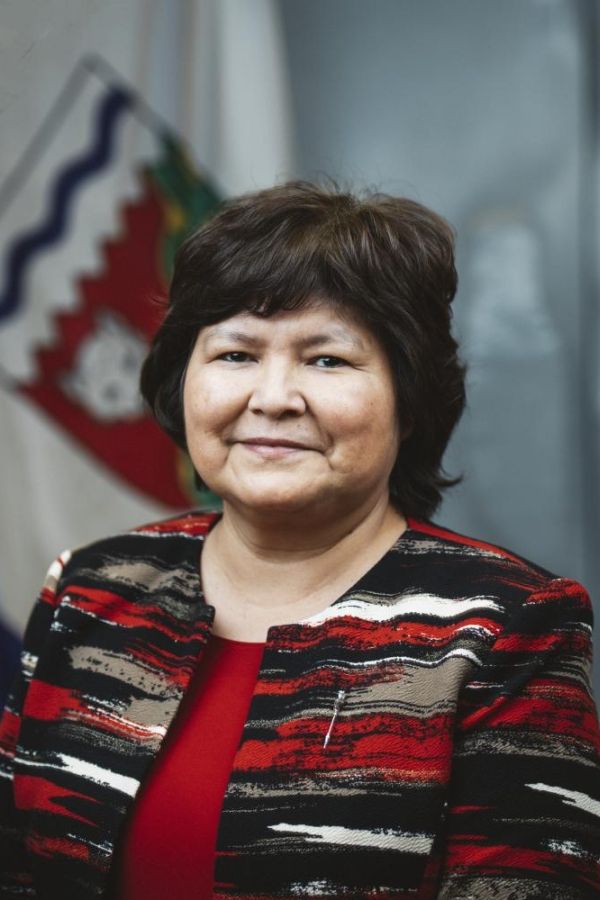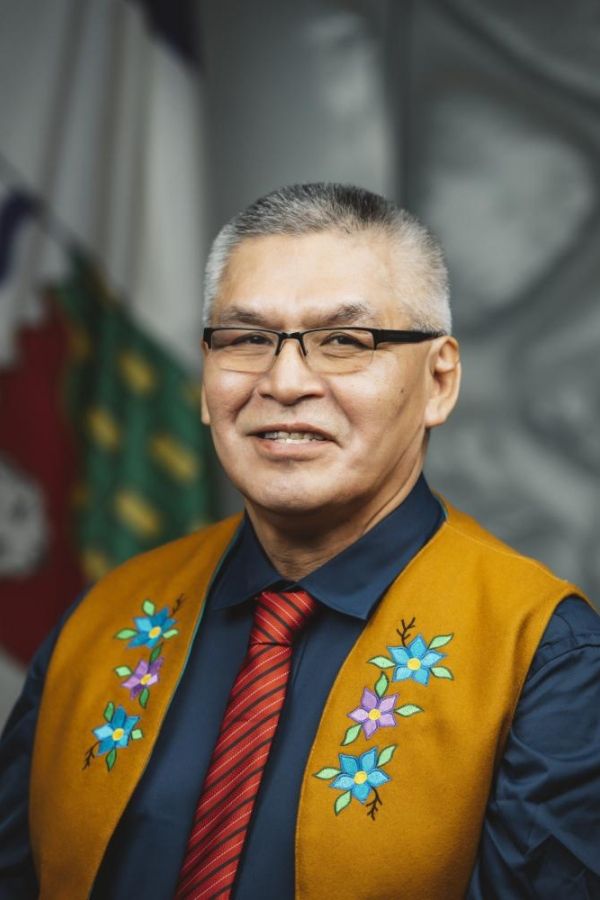
Thank you, Mr. Chair. Thank you for the answer. The other question I have is in regards to capital assets on the retrofit fund. For the Aklavik, they were working on the septic tank in Aklavik and they came into some problems. Can you give me some update on what's been done so far? Like, is it safe? You always talk about safety of human lives, and is this project safe for the students and the staff within the school? Thank you, Mr. Chair.
Thank you. I'll go to the Minister.

Thank you, Mr. Chair. I'll direct this to the assistant deputy minister, please, MacKay, please.
Thank you. I'll go to the ADM.
Thank you, Mr. Chair. An environmental consultant has come in and removed the piece of material that was knocked off during the renovation and has taken it back for testing and stabilized the space where the piece of material fell off. And also they've reviewed the ventilation system to confirm that the ventilation does not run through that crawl space, so it's safe for occupants to use.
Thank you. I'll go to the Member from Mackenzie Delta.

Thank you, Mr. Chair. It's more of a comment. I've seen people work with asbetos in the Mackenzie Delta and when they work in those areas, they confine -- they seal the whole area right off before they even work on it and they use special equipment and ventilation and all that precautions before they even start work or -- in that area. So it's pretty well contained. And so hopefully there's no contaminants that will place the students and the staff in danger because they're still using the facility at this time. Thank you, Mr. Chair.
Thank you. Is there any questions from Members? Seeing none, I'm going to go to the Department of Infrastructure, asset management, infrastructure investments, $93,935,000. Does the committee agree?
Agreed.
Thank you, Members. Please turn to page 58, energy and strategic initiatives, with information items on page 59. Are there any questions? I'm going to go to the Member from Great Slave.
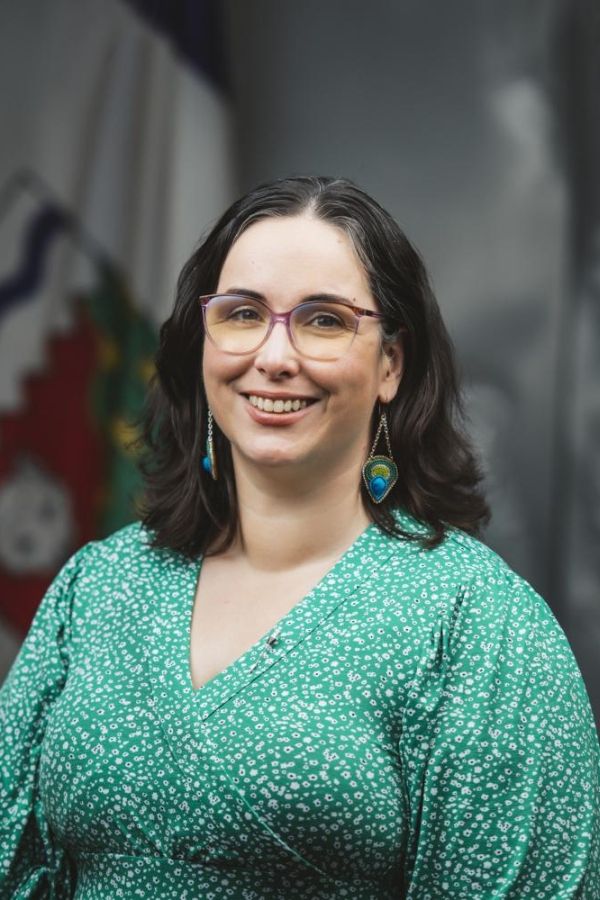
Thank you, Mr. Chair. With regards to the Slave Geological Province corridor planning and environmental assessment, could the Minister please give us a substantiation for that? Thank you.
Thank you. I'll go to the Minister.

Thank you, Mr. Chair. I'm certainly happy to do that. So this project obviously represents a pretty significant potential in infrastructure investment. At this stage, the project is focused on planning as far as Lockhart All-Season Road. That would take from the end -- what is now the end of the Ingraham Trail, commonly known thereof as Ingraham Trail or Highway No. 4, all the way up to Lockhart Lake, and the funding that is here right now would get as far as having a regulatory application in 2025-2026 in order to begin an environmental assessment.
This certainly has been around, as I said, for some time. This was initially advanced back in 2019, and certainly interest has continued in getting to a point where a decision on whether or not to proceed could actually be made. So that's, you know, really a big part of the investment here is for that purpose. This is 75/25 percent funded with the federal government, and the costs to date have been around planning and regulatory review studies. And the work -- you know, again, because of the nature of it, it continues to reflect priorities around economic growth and economic foundations as well as in this case a collaboration with Indigenous governments. Mr. Chair, I continue to receive correspondence from YKDFN and Tlicho governments, in particular, around their interest in seeing this advance and seeing what stage it's at. Mr. Chair, I'm mindful of time. I'll pause there and see what other questions the Member might have. Thank you.
Thank you. I'll go back to the Member from Great Slave.

Thank you, Mr. Chair. So I would like to know if the Minister can explain how she sees the timelines of this particular environmental assessment aligning with the regional strategic environmental assessment that is underway. Thank you, Mr. Chair.
Thank you. I'm going to go to the Minister.

Thank you, Mr. Chair. Mr. Chair, so the regional strategic environmental assessment is led by the federal government. So far be it for me to speak on their behalf, but I am aware that there's been some delays in getting that underway. I'm also cognizant that certainly some of the regional governments are indicating, and the federal government has confirmed, that we would -- that this project and its environmental assessment can move forward even while or in tandem with a regional strategic environmental assessment. It's been our understanding and expectation, frankly, that the two can be supportive of one of the other. The information that we would be doing for an environmental assessment would be relevant to the regional environmental assessment and vice versa. So as far as a more detailed response than that, I'd need to confirm what the latest federal plans are on the RSE, and I don't have that in front of me. Thank you.
Thank you. I'm going to go to the Member from Great Slave.

Thank you, Mr. Chair. Would the Minister be willing to follow up in writing with committee on that? Thank you.
Thank you. I'm going to go to the Minister.

Thank you, Mr. Chair. Yes, Mr. Chair, assistant deputy Jenkins does indicate what we are told is that they're getting started this year, so I'll -- we'll go back and see if we can't get something more definitive from the partners that sit at that table, and then we'd be more than happy to follow up or at least give an update if I'm waiting on someone else for information. Thank you.
Thank you. I'm going to go to the Member from Great Slave.

Thanks, Mr. Chair. I appreciate that. Nothing further.
Thank you. Next on my list I have is the Member from Frame Lake.

Thank you, Mr. Chair. So, Mr. Chair, my questions are around kind of the -- all three of the big kind of planning projects that we've got here. To be clear, the Taltson, Mackenzie Valley Highway, Slave Geologic Province.
So it appears that the fiscal responsibility policy does not require any kind of assessment of O and M implications for proposed capital projects and whether the government could even afford those costs going forward. So I guess I'm just kind of curious how this much -- how planning for building of this kind of -- this much infrastructure all at once fits within, you know, the Minister's -- finance Minister's perceptions of what the implications of the fiscal responsibility policy are? That's my first question.
Thank you. I'm going to go to the Minister.

Thank you, Mr. Chair. Mr. Chair, it's -- I'm always happy when someone is referencing the fiscal responsibility policy, but I don't know that that's -- that policy's really meant to guide the development of the fiscal strategy and the fiscal stewardship on the operations side yet not necessarily in the same way as it applies here, although I know that may be something to look at for the future into how they intersect one with the other. But as far as the three big projects, they are each at different stages and they do each have slightly different obviously sort of end goal benefits.
Fundamentally, all three are opportunities to see a catch-up in the scale of infrastructure that exists in the Northwest Territories, particularly in terms of transportation infrastructure. The Mackenzie Valley Highway at this point, as is spoken of quite frequently, is a critical corridor up the -- you know, up a part of Canada that is right now thoroughly underserviced in terms of the transportation network. It's already in EA. We are working very hard to make sure that there is no delay, that -- certainly from our end on that EA process and expect it out next year with then the ability to proceed according to what the board may dictate and move forward with a design and a procurement process -- or rather regulatory process and then design procurement. So that's where that one's at. It's at a very different point. With that in hand, we can go and get final dollars hopefully from the federal government to support its building.
The Taltson project's a little different in that we are but one member. That is being led by all of the Indigenous governments who are in the watershed region. The GNWT's one number of that group. That project will advance as a group. It's not expected to advance with the GNWT alone, and it certainly wouldn't advance without support from the federal government financially. But it is different, again, in that it's advancing step by step with that entire group, so multiple MOU partners sitting together. And it is on the side of the energy infrastructure needs.
And then last but not least, of course, Slave Geologic Province, Mr. Chair. Again, you know, noting again the complete lack of any roadways in this country connecting the south to the Arctic, and this is an opportunity to do so. The Nunavut government has reinvigorated their work on creating a report and hoping to see it connect down into our territory. But that is for this one off out of the three. But without continuing to make some progress to advance, we wind up in the situation we've been in for 30 years which is people talk about it, but nothing's actually studied and nothing's ready to go. So the funds we have here are really to -- for Taltson and -- or for -- rather for Slave Geologic gets to a point where we can make an actual decision where we know what the project would look like, where it would be, who would be interested, and who might contribute. But right now, without that, we just keep talking about the lack of infrastructure. Thank you.
Thank you. I'm going to go to the Member from Frame Lake.

Thank you, Mr. Chair. So yeah, I'm kind of curious in particular on -- to get a bit deeper into kind of O and M costs. So any of the projects will do, really. I mean, any of them have implications for that. So how do we propose affording to operate additional infrastructure like this? I mean, looking at our fiscal outlook, looking at the infrastructure we've got, it seems like we're having a very difficult time kind of affording what we've already got. So who are we envisioning is going to pay for the operations? Are we anticipating developing cost sharing agreements with other governments? How are we -- how are we proposing that this is going to be something that we can even afford? Because getting capital money is one thing but operations and maintenance, of course, is going to be enormous for any of these large projects. So what's our planning around that? Like, how are we ensuring that what we're doing is realistic and within the bounds of what the territory can afford to do?
Thank you. I'm going to go to the Minister.

Thank you, Mr. Chair. Mr. Chair, the GNWT is having significant challenges maintaining its operations. We are struggling in the health care system obviously with the health authorities running a fairly significant deficit that continues to grow, and struggling in the energy sector right now because of the lack of interconnectivity between our systems and the tremendous costs that continue to build up because of the reliance on diesel and the volatility of fuel. But our fiscal challenges aren't necessarily being driven by operations and maintenance on the highways. Those costs are going up. I mean, I certainly am seeing it on the -- you know, in the Tlicho with the winter roads, the winter roads going up. The Sahtu is likely to see increases. But that is not what keeps the finance Minister up at night. The situations facing us with -- in terms of the health authority budgets is of a bigger concern, of the energy sector is a bigger concern. But operations on highways and roads, again quite frankly, Mr. Chair, their costs are not insignificant, the building costs are not insignificant, but the costs of not having transportation and being in a situation where I can't resupply communities in fuel services division, where we can't get supplies in when there's an evacuation in Yellowknife for instance, those costs are also significant. So we do -- I do want, you know, again emphasize estimates are made before a construction decision is made as to what the total might be. And I'll use an example of the TASR where they've entered into a P3 project. That TASR project has a set amount that we can plan for every year. There's an amount in a sinking fund that we use to pay for the operations and maintenance of that highway that goes to the Tlicho government who are the third party. That kind of work is certainly being contemplated for these other projects. Again, Taltson in particular, it's going to be a cooperative -- cooperation project. The next stage is to get an entity that these Indigenous governments can be part of. That may well be where the business case for Mackenzie Valley Highway or Slave Geologic end up, but I don't have that information yet. That's the next step for Mackenzie Valley Highway, quite frankly, is to have that conversation. Thank you.
Thank you. I'm going to go to the Member from Frame Lake.

Thank you very much, Mr. Chair. And so, you know, I appreciate that answer from the Minister. I'm very glad that they are considering the O and M for these. You know, that does bring me some comfort.
So I want to speak a little bit -- I mean, we heard from the ECE Minister just today detail the magnitude of costs for infrastructure for the college, for example. And of course, there's only so much federal money we can seek. The same can be said for housing, which MLAs have been clear is a priority. And so one of the problems we have is we can only seek so much federal funding. We can only receive so much federal funding. So how are we able to effectively action our priorities when we're simultaneously trying to advance multiple projects that are outside the possibility of affordability for the territory to build and also trying to advance what I might describe as competing priorities. So help me understand how it all makes sense. How are we going to effectively -- because, I mean, this has been one of the conversations we've been having over and over and again in the House, you know, during this budget session is, you know, how do we effectively action our priorities? And if all of our planning and staff time and federal funding is going towards other projects, of course the opportunity costs is that we're losing out on things that we also have prioritized. So I'm trying to understand how to make sense of all this and make sense of the -- you know, the Minister's gotten up, and with a very somber expression, spoken about dire financial outlook but we seem to be planning as if our fiscal outlook is positively incredible. So, Mr. Chair, if the Minister could kind of comment on that statement, I'd appreciate it.
Thank you. I'm going to go to the Minister.

Thank you, Mr. Chair. I hope I don't just have 40 seconds. That's a big one. Mr. Chair, at this point these three projects do have federal funding to get them to that point where there's an understanding that -- you know, the environmental assessment work wouldn't necessarily become stale if it doesn't happen to move forward with funding in the immediate year after. It goes through still a permitting process. And even with the permits in hand, I can think of a mining project here in the territory that's been sitting fully permitted ready to go trying to get funding sorted. They are not -- it doesn't go stale. It doesn't go bad. Obviously at some point it becomes not a tangible priority. But having those permits in hand doesn't mean that we're under the clock or under the gun to have it funded the next year. It certainly gives the opportunity to go and have a conversation. It's not possible to go to Ottawa and say, will you fund a project that I haven't -- I'll put through in EA that I haven't got a regulatory permit for that I'm not really sure where I'm going to put it, but can you fund it. So that -- these three are all at different phrases of that kind of planning and preparation so that we can go with a meaningful business case with permits in hand to say we're ready, it's shovel ready, let's move forward.
In terms of balancing different priorities, Mr. Chair, this is certainly a bigger question and probably one better placed to the Premier in the sense that it applies -- we would be looking to the federal engagement strategy that is a whole of government strategy and a whole of Cabinet strategy that does look to be founded upon the priorities of the 20th Assembly and the mandate that's developed to deliver upon that.
To date, Mr. Chair, we -- obviously the housing funding that we have is, you know, outside the wheelhouse of what I have in front of me to speak to today. But it comes from different sources in the federal system as well, so we want to be able to be in a position to maximize what is coming in the territory from every single federal funding source. Canada Health, you know -- or sorry, the -- I'm getting the acronym wrong. They've changed the federal government's department of late but it's now housing, infrastructure, and communities. There's a very specific pot of money and it's very large, and we want a lot of it to come here. But there's a point that we might need to make too about also making sure that we have other things that are moving forward. So we've been fortunate to date. There is a lot of money that's come into the housing corporation, a lot of money has come into Indigenous governments for housing, and we've still been able to advance these projects.
So with all of that said, Mr. Chair, that's the goal, is to continue to achieve that kind of success where things can each continue to move at slightly different stages which allows that money to flow out. Thank you.
Okay, thank you. I'm going to go to the Member from Yellowknife North.

Thank you, Mr. Speaker -- sorry, Mr. Chair. It's been a long day.
I wanted to start just picking up the conversation first with Taltson pre-construction planning. I understand that for now we have 100 percent federal funding to continue with the planning, and I understand the GNWT is only one partner at the table; however, I think it's time for us to start considering what the GNWT's own portion of the future investment would need to be and to contemplate -- in a public way, to have those numbers out there publicly and to have the discussion as to whether that GNWT portion of the investment, both in terms of capital and ongoing O and M, is realistic, is palatable for people. And so I ask the Minister today would she make public what is estimated to be the cost to the GNWT of a Taltson project starting with phase one. Thank you, Mr. Chair.
Thank you. I'm going to go to the Minister.

Thank you, Mr. Chair. Mr. Chair, so typically a large project like that, the planning estimates would come through the -- or sorry, this capital planning process if it gets to that stage. But, Mr. Chair, let me take a slightly different approach with this one which is to say, again, it is an MOU-based approach. And I have been very clear with the partners when I sit at that table that it is an MOU approach, that it is not a GNWT only project; it is meant to advance as a group. And, again, our next step was to try to create -- there's been a decision on a preferred route. There's been a lot of discussion about how GNWT can support those partners with resolving their legacy issues and a change in terms of maybe having a stronger role there because it hasn't been resolved to date. And then the next stage would be to try to create a -- what we call project company or project co which can be the entity that actually advances the project, becomes the proponent. So I'd like to propose that I go back and make a commitment that I'll go back to that group, to the steering committee, and discuss how we can do better to maybe socialize some of the numbers. I think other members of that group are also looking to be able to engage their membership so that everyone is aware as to what the kind of project is at scale. So, again, I do want to go back to them, but I'm going to make a commitment that I'm going to do that and see if we can all get the information out so that GNWT, public, but also members who are members of those groups can benefit from that. Thank you.
Thank you. I'm going to go to the Member from Yellowknife North.

Thank you, Mr. Chair. I do think that that is an important step, so I appreciate the Minister taking that back to the working group.
I want to turn now to the Slave Geological Province corridor planning. So the Minister mentioned that this one is actually only 75 percent federal funding. Can the Minister explain to us how much of the GNWT's own money we're using for the planning, both this year and over the course of the -- is it four or five years that we have federal funding; how much is the GNWT spending of our own money on this? Thank you.
Thank you. I'll go to the Minister.

Thank you, Mr. Chair. So the totality of this, of what is planned to do all of the planning, is a $40 million project. That is cost shared 75/25 federal to GNWT. Thank you.
Thank you. I'm going to go to the Member from Yellowknife North.

Okay, so that would amount to $10 million of GNWT funding just for planning, which I would consider a very significant amount of money for something we're not even sure is a good idea.
In terms of this project's priority ranking, I know that all the projects go through the planning process. We see at the back of our books that it has to be evaluated according to impact, severity of impact, and urgency in mitigation. Can the Minister share with us how this project was rated in terms of the urgency of the project, the severity of the impact, and also mitigation, so what other options could there be instead of this project; how were those rated in terms of priority? Thank you, Mr. Chair.
Thank you. I'll go to the Minister.

Thank you, Mr. Chair. Mr. Chair, this project initially came to -- into play for the GNWT before my time even in this House. And so its initial conception did not go through the same exact processes that we have now put into place today. But understanding the kinds of potential outcomes -- and I'm just trying to get to the substantiation sheet where there's a macroeconomic analysis lens that has since been applied to the project, due to the time, to try and determine what some of the benefits would be. Sorry, Mr. Chair, I'm just looking through -- oh, Mr. Chair, look, it's coming right at me now.
So -- yes, so as I said, initially when it came through the GNWT's process back in 2018-ish, or perhaps earlier than that, did not necessarily have the same rigor that we're applying now. But it has continued to go through the process, and it is being -- the same lenses are being applied now. So, for example, the macroeconomic lens considerations that every project does go through has economic effects estimated as being growth in terms of output in jobs over 30 years. Somewhere between 17,000 to 33,000 in gross sort of outputs, and then 20,000 to 40,000 in jobs. And the idea there, of course, is trying to analyze what the potential impacts would be over that period of time for having access to this region in a way that we do not currently.
Specific employment opportunities in terms of person positions, somewhere between 680 and 1,400 per year rather than over 30, a little bit of an easier number to grasp, Mr. Chair. And showing actually benefits that could be realized not only in the Northwest Territories but Canada which would be important for seeking investment from the federal government. I mean and, again, going on in this particular lens with the different benefits that it could have.
So, you know, Mr. Chair, there's -- the other assessments are done. I'm not sure -- again, I'm conscious of the time so I'm going to stop there, Mr. Chair. But if there's a specific item that's from the lens or the risk analysis that the Member wants me to speak to, I'm happy to do that.
Thank you. I'm going to go to the Member from Yellowknife North.

Thank you, Mr. Chair. So my understanding was that it already had been rated in terms of priorities under those categories that I mentioned, but if it has not, then I would strongly urge this government to do those ratings and then to be able to compare to other projects that we're considering and in terms of, you know, by the same apples to apples what, you know -- what is the severity of how this would impact people if we don't do it, how urgent is this. And then in particular, I think this is underrated, the question of mitigation, what else could we do instead? Is this the only possible option to achieve those outcomes? Is this the only possible way we could get any of those jobs, or are there other possible solutions we could consider that could cost less money and put less of a burden on our fiscal situation here?
So I guess I'll request from the Minister that she come back to us for this project with an explanation of how this project is rated in terms of those categories of priority with a bit of explanation for each as to why the government might feel that it is urgent or that there's nothing else possibly that could achieve the ends sought. Thank you, Mr. Chair.
Thank you. I'm going to go to the Minister.





